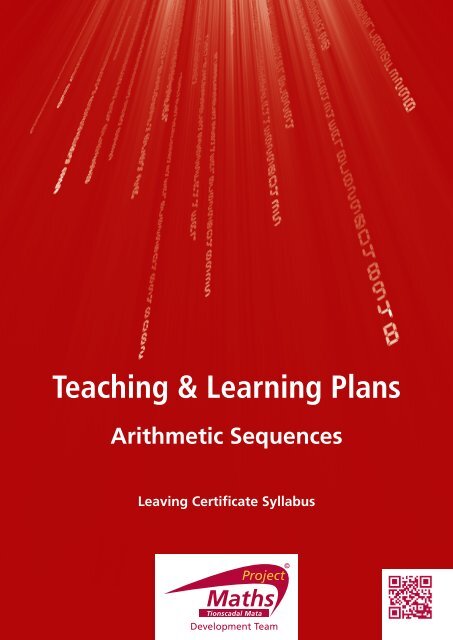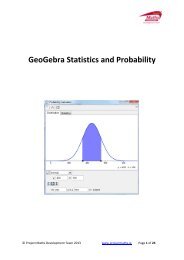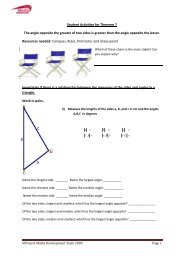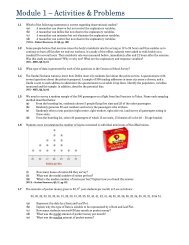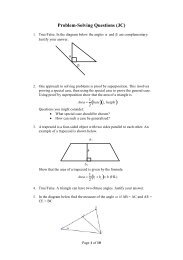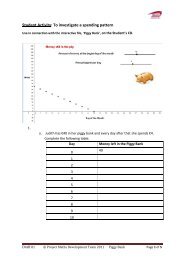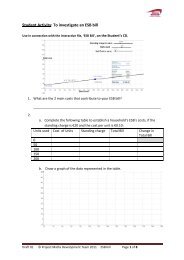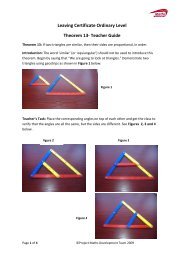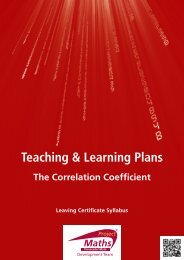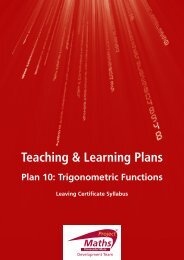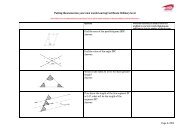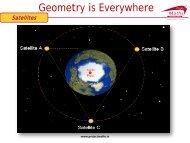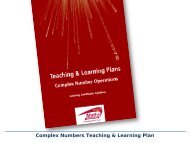Teaching & Learning Plans - Project Maths
Teaching & Learning Plans - Project Maths
Teaching & Learning Plans - Project Maths
You also want an ePaper? Increase the reach of your titles
YUMPU automatically turns print PDFs into web optimized ePapers that Google loves.
<strong>Teaching</strong> & <strong>Learning</strong> <strong>Plans</strong>Arithmetic SequencesLeaving Certificate Syllabus
<strong>Teaching</strong> & <strong>Learning</strong> Plan: Arithmetic SequencesStudent <strong>Learning</strong>Tasks: Teacher InputLesson InteractionStudent Activities: Possible ResponsesTeacher’s Support andActionsAssessing the <strong>Learning</strong>Section A: To introduce arithmetic sequences or arithmetic progressionsand gain an understanding of the formula T n = a + (n - 1) dTeacher Reflections»»Can you give meexamples of patternsyou have alreadyencountered?• Blue, red, blue, red...»• 2, 3, 5, 8, 12...»• 1, 4, 9, 16, 25...»• 3, 8, 13, 18, 23...• Students should try out these questions,compare answers around the class andhave a discussion about why their answersdo not all agree.»»Revise the concept ofpattern as dealt withat Junior Certificatelevel.»»Are the studentsfamiliar with patterns?»»»Have students comeup with examples ofdifferent patterns?»»Can you now doquestions 1 - 4 onSection A: StudentActivity 1?»»Distribute Section A:Student Activity 1 tothe students.»»»Give students time toexplore and to discusswhat is happening.»»Can students see thatthese problems have apattern?»» » Do students recognisethat any term (apartfrom the first term) inthe various patternsis formed by adding afixed number to thepreceding term?© <strong>Project</strong> <strong>Maths</strong> Development Team 2012 www.projectmaths.ie KEY: » next step • student answer/response 3
<strong>Teaching</strong> & <strong>Learning</strong> Plan: Arithmetic SequencesStudent <strong>Learning</strong> Tasks: Teacher InputStudent Activities: PossibleResponses• For each question we weregiven an initial value and avalue that was added to eachprevious term to generate thenext term.Teacher’s Support andActionsAssessingthe <strong>Learning</strong>»»What have the first three questionsin Section A: Student Activity 1 got incommon?»»»Teacher Reflections»»Sequences where you are given an initialterm and where each subsequent term isfound by adding a fixed number to theprevious term are known as an arithmeticsequences or arithmetic progressions (APs).»»»The initial term is denoted by a and d isused to denote the common difference. dis the number that is added to each term togenerate the next term.»»»»»This notation is used by mathematicians.»»Write the words'arithmetic sequence'on the board.»»»»»»Write a = Initial term(First term) and d =number added toeach consecutive term(common difference) onthe board.»»We call the 4 th term T 4 , the ninth term T 9and the n th term T n .»»»»In each of the three problems on theSection A: Student Activity 1, ask how wegot each term?• We were given an initial terma and the next term was foundby adding d (the commondifference) to this initial termand then the 3 rd term wasfound by adding d to thesecond term.» » Write• 4 th term =T 4• 9 th term =T 9• n th term =T n on theboard.© <strong>Project</strong> <strong>Maths</strong> Development Team 2012 www.projectmaths.ie KEY: » next step • student answer/response 4
<strong>Teaching</strong> & <strong>Learning</strong> Plan: Arithmetic SequencesStudent <strong>Learning</strong> Tasks:Teacher Input»»Now let’s see if we cancome up with a formulafor T n ?»»Student Activities: PossibleResponses• Students should try thisthemselves and compareanswers around the class andhave a discussion about whythe answers do not all agree.»Teacher’s Support and ActionsAssessing the<strong>Learning</strong>»»Were students ableto come up withthe first 5 terms?»»»Start with T 1 . What is T 1in terms of a and d?»»Then move on to T 2 . If weknow what T 1 is, how dowe find T 2 ?»»Write out the next threeterms.»»»»Do you notice a patternoccurring?»»»»So what is T 8 ?»»What is T 38 ?• T 1 = a»• We add ‘d’ to T 1 to get T 2 so T 2= a + d»• T 3 = T 2 + d = a + d + d = a + 2dT 4 = T 3 + d = a + 2d + d = a +3dT 5 = T 4 + d = a + 3d + d = a + 4d• Yes, the number of ds is alwaysone less than the term we arelooking for.»• T 8 = a + 7d• T 38 = a + 37d»»Give students time to exploreand discuss what is happening.»»»Write the following on theboard as students come up withthe terms.T 1 = aT 2 = a + dT 3 = T 2 + d = a + d + d = a + 2dT 4 = T 3 + d = a + 2d + d = a + 3dT 5 = T 4 + d = a + 3d + d = a + 4d...T n = a + (n - 1) dNote: Explain that this formula onlyapplies to an arithmetic sequencethat d always has to be a constantand a is the first term.»»Do studentsrecognise thatfor a particularsequence, d alwayshas the samevalue?»»»Do studentsrecognise that the8 th term isT 8 = a + (8 - 1)d,T 38 = a + (38 - 1)d,T 107 = a + (106)d,before getting T n ?» » Do studentsunderstand themeanings of a, dand T n = a + (n - 1)d?Teacher Reflections»»What is T 107 ?• T 107 = a + 106d»»What is T n ?• T n = a + (n - 1)d© <strong>Project</strong> <strong>Maths</strong> Development Team 2012 www.projectmaths.ie KEY: » next step • student answer/response 5
<strong>Teaching</strong> & <strong>Learning</strong> Plan: Arithmetic SequencesStudent <strong>Learning</strong> Tasks:Teacher Input»»Continue with Section A:Student Activity 1.Student Activities: PossibleResponsesTeacher’s Support and ActionsAssessing the<strong>Learning</strong>»»Are studentscapable ofansweringthe questionson Section A:Student Activity1?Note: Students will need to understandthat a and d may be fractions, decimalsor negative numbers. They should beallowed to discover this rather thanbeing told at the beginning of theactivity sheet. They should also recognisethat n is always a positive integer.Teacher Reflections»»Questions on Section A: StudentActivity 1 can be done incrementallyand answers discussed with the class.»»Conduct a discussion on what hasbeen learned to date on arithmeticsequences.»Reflection:»»What is an arithmeticsequence?»»»»»»What is a?»»What is d?»»What is n?»• An arithmetic sequence is onein which each term, apart fromthe first term, is generated byadding a fixed number to thepreceding term. »• a is the first term• d is the common difference• n is the number of terms»»More time may have to be spent onthe questions in Section A: StudentActivity 1 should the rate of studentprogress require it.»»»Having cognisance of the students’abilities, select which homeworkquestions on this activity sheet are tobe completed.»»Are studentsfamiliar with thenotation a, d, nand T n ?» » Can students usethe formula »T n = a + (n - 1) d?»»What is the meaning of T n ?• T n is the n th term»»What is the formula for T n ?• T n = a + (n - 1) d»»For homework, completethe following questions (picksuitable questions) from theSection A: Student Activity 1.© <strong>Project</strong> <strong>Maths</strong> Development Team 2012 www.projectmaths.ie KEY: » next step • student answer/response 6
<strong>Teaching</strong> & <strong>Learning</strong> Plan: Arithmetic SequencesStudent <strong>Learning</strong> Tasks: TeacherInputStudent Activities: PossibleResponsesTeacher’s Support andActionsAssessing the<strong>Learning</strong>Section B: To further explore the concepts of arithmetic sequence andattempt more difficult exercises»»Class, I would like you to divideinto groups of 2 (or 3) and ona sheet of paper write a listof examples / applications ofwhere arithmetic sequencesoccur in everyday life. Justifywhy your examples arearithmetic sequences.»»Let’s look again at the formulaT n = a + (n - 1) d.»»Complete Section B: StudentActivity 2.• Saving regular amounts.»• Depreciation or inflation byregular amounts.»• Spending regular amounts.»• Heights of buildings where eachfloor above the ground floor isthe same height.»• Removing regular equalamounts from a container.Note: Students need to ableto come up with examples ofarithmetic sequences otherthan those they already metin class. They should also beable to recognise, with theirteacher's help, what makesthe sequences they chosearithmetic. Add examplesof sequences that are notarithmetic and discuss thesealso.»»»Give students time todiscuss their examples.»»Distribute Section B:Student Activity 2.»»Select questions dependingon students’ progressand abilities. Include keyquestions 8 and 12-14. »»»Give students anopportunity to attemptquestions before thesolutions are demonstratedon the board.»»Are studentscapable ofjustifying thatthe sequencesthey chose arearithmetic?»»Are studentscapable ofapplying theformula »T n = a + (n - 1) d?» » Are studentscapable ofdevelopingstories fromgraphs?Teacher Reflections© <strong>Project</strong> <strong>Maths</strong> Development Team 2012 www.projectmaths.ie KEY: » next step • student answer/response 7
<strong>Teaching</strong> & <strong>Learning</strong> Plan: Arithmetic SequencesStudent <strong>Learning</strong> Tasks: Teacher InputStudent Activities: PossibleResponsesTeacher’s Support andActionsAssessing the<strong>Learning</strong>Section C: To enable students understand how simultaneous equationscan be used to solve problems involving arithmetic sequences»»Solve this problem: “Mark’s savingspattern obeys an arithmetic sequence.On the 4 th week he saved €9 and onthe 6 th week he saved €13.»»Design 2 equations in terms of a and dto represent Mark’s savings pattern.»»»How do we solve these equations?»»»»»»»»»»»What does a = 3 and d = 2 mean in thecontext of the question?»»»»»How much will he save in the 10 thweek?• a + 3d = 9a + 5d = 13• Students should comeup with the concept ofsimultaneous equations.»a + 5d = 13a + 3d = 92d = 4d = 2a + 5(2)= 13a = 3• Mark saved €3 in the firstweek and increased theamount he saved eachweek by €2.• T 10 = 3 + (10 - 1) 2T 10 = 21»»Ask an individual studentto write the solution onthe board and explainwhat he or she is doing ineach step.»Note: Students shouldalready be familiar withsimultaneous equations,but may need a quickrevision exercise on howto solve them. It shouldbe emphasised thatsimultaneous equations canbe represented by lettersother than x and y.»»The time spent on thissession will depend onthe students’ abilitiesand the understandingthey already have ofsimultaneous equations.»»»Another example mayneed to be used here ifstudents are unfamiliarwith this concept.»»Can studentsrecognisewhat a set ofsimultaneousequations are?»»»Do studentsrecognise that thea and the d havethe same value inboth equations?»» » Can studentssolve thesimultaneousequations?Teacher Reflections© <strong>Project</strong> <strong>Maths</strong> Development Team 2012 www.projectmaths.ie KEY: » next step • student answer/response 8
<strong>Teaching</strong> & <strong>Learning</strong> Plan: Arithmetic SequencesStudent <strong>Learning</strong> Tasks:Teacher Input»»Complete Section C: StudentActivity 3.Student Activities: PossibleResponsesTeacher’s Supportand Actions»»Distribute Section C:Student Activity 3.Assessing the <strong>Learning</strong>Note: Pick the appropriatequestions for the class, reservingsome for homework and excludenumbers 10-12. At this point.Note: For questionNo 7, weight lossis normally not aconstant loss permonth hence weightloss is not a goodexample of anarithmetic sequence.»»Write a varietyof simultaneousequations from thestudents on theboard together withtheir solutions. »»»Are students able toestablish and solve thesets of simultaneousequations that representmost of the problemsin Section C: StudentActivity 3?Teacher Reflections»»I would like you to work inpairs and devise your ownquestion(s) similar to the onesin this Student Activity. Thengive the questions to thegroup next to you so that theycan solve them.• Students exchange theirequations.»• Students offer theirsolutions and explain howthey arrived at them.»»Allow students totalk through theirwork so that anymisconceptionsbecome apparentand are dealt with.» » Are students capableof devising their ownquestions?© <strong>Project</strong> <strong>Maths</strong> Development Team 2012 www.projectmaths.ie KEY: » next step • student answer/response 9
<strong>Teaching</strong> & <strong>Learning</strong> Plan: Arithmetic SequencesStudent <strong>Learning</strong> Tasks: Teacher InputStudent Activities:Possible ResponsesTeacher’s Supportand ActionsAssessing the<strong>Learning</strong>Section D: To enable students deal with problems like the following:Teacher Reflections»»A mobile phone supplier charges €5 plus €0.10per call.»»»What is the charge when the user makes 8 calls?»»»Which term of the sequence is this?»»»Does the cost of using this supplier form anarithmetic sequence?»»»Why do you say it forms an arithmetic sequence?»»»»• €5.80• 9th»• Yes»»• Because you add 0.10for every call made,so it has the commondifference.»»»Put the followingcosts on theboard:»€5 plus €0.10 percall.»»»Allow students totalk through theirwork so that anymisconceptionsbecome apparentand are dealtwith.»»Can studentsdistinguish whichformula to use?»»»Do studentsunderstand whyin this questionthe term thatrepresents the10 th call is the 11 thterm?»»What value has a in this sequence?• 5»»»What value has d in this sequence?• 0.10»»»Which term in the sequence represents the 10thcall? »»»This is something you need to watch out for inquestions.»• 11th term»»»»»»»Explain why it happened in this question?»»»Now attempt questions 10 -12 in Section C:Student Activity 3.• Because the initialterm was for no callsrather than one call.© <strong>Project</strong> <strong>Maths</strong> Development Team 2012 www.projectmaths.ie KEY: » next step • student answer/response 10
<strong>Teaching</strong> & <strong>Learning</strong> Plan: Arithmetic SequencesStudent <strong>Learning</strong> Tasks: TeacherInputStudent Activities:Possible ResponsesTeacher’s Support and ActionsAssessing the <strong>Learning</strong>Section D: To enable students see that not all sequences are arithmetic sequences.Note: the Fibonacci sequence is not specified in the syllabus, but is a famous mathematical sequence and a class of more ablestudents may enjoy exploring this sequence. However, at this stage in the T&L teachers need to challenge their students toprovide examples of some sequences that are not arithmetic.»»Are all sequences arithmetic?Explain your reason.»»»There is a famous sequencecalled the Fibonacci Sequence.See Section D: StudentActivity 4.»»Is this an arithmetic sequence? »»»Can you give examples ofother sequences that are notarithmetic?• No. To be an arithmeticsequence T n - T n -1 mustbe a constant for all theterms.»»»»• No.»»Distribute Section D: StudentActivity 4.Note: Some students mayneed individual help with theexplanation of how the sequencedevelops. (See the differentrabbit faces.)»»»Delay telling students that thisis not an arithmetic sequence.Allow students to explore thisfor themselves.»»»Are students ableto identify thecharacteristics of anarithmetic sequence?»»»Are students able toderive the terms of theFibonacci Sequence?»» » Have students comeup with examples ofsequences that are notarithmetic?Teacher ReflectionsNote: While not specificallyrelated to this <strong>Teaching</strong> and<strong>Learning</strong> Plan, this section isimportant for two reasons (i)the Fibonacci Sequence is animportant mathematical sequenceand (ii) it is very important thatstudents are reminded that notall sequences are arithmetic.© <strong>Project</strong> <strong>Maths</strong> Development Team 2012 www.projectmaths.ie KEY: » next step • student answer/response 11
<strong>Teaching</strong> & <strong>Learning</strong> Plan: Arithmetic SequencesStudent <strong>Learning</strong> Tasks:Teacher Input»»Class, complete questions1-6 on Section D: StudentActivity 4 on the FibonacciNumber Sequence.Student Activities: PossibleResponses• 1• 2• 3• 5• 8• 13• If we add together any twoconsecutive terms we get thenext term.Teacher’s Support and ActionsNote: The Fibonacci sequence is {0, 1, 1, 2,3, 5, 8, 13, , , }, hence the explanation ofno rabbits in the first month.Assessingthe <strong>Learning</strong>Teacher Reflections»»Can you see a patterndeveloping?Note: To explain why the first term iszero: explain that there were no rabbitsin the first month. Then, there was 1pair in the second month etc. A morecomplicated explanation of the Fibonaccirabbit problem can be found at http://en.wikipedia.org/wiki/Fibonacci_number»»If computers are not available, hardcopies of the quiz can be printed forthe students.»»Did thestudentsrecognisethepattern?»»Now, I want you all to trythe interactive quiz called“Arithmetic SequenceQuiz” on the Student’s CD.Reflection:»»Describe an arithmeticsequence.»»• The difference between anyterm and the preceding term isalways the same or T n - T n-1 is aconstant for all the terms.»» » Circulate and take note of anyquestions or difficulties students havenoted and help them answer them.»»Write down two formulaused in connection witharithmetic sequences andwhat does each letter usedmean?»»»Write down any questionsyou have on this section ofthe course?• T n = a+(n-1)dT n - T n-1 = d (The commondifference)a = first termd = common differencen = the termT n = the n th termT n-1 = the term before the n thterm.© <strong>Project</strong> <strong>Maths</strong> Development Team 2012 www.projectmaths.ie KEY: » next step • student answer/response 12
<strong>Teaching</strong> & <strong>Learning</strong> Plan: Arithmetic SequencesSection A: Student Activity 11. A gardener buys a plant that is 12cm in height. Each week after that theplant grows 10cm. Note: The plant is 12cm high at the beginning of thefirst week.a. What will be the height of the plant at the beginning of the 1 st , 2 nd , 3 rd ,4 th and 5 th weeks, if it follows the same pattern?b. Use graph paper to represent the pattern from part a.c. Explain your reasoning.d. What two pieces of information were you given initially?2. The ground floor of a building is6 metres in height and each floorabove it is 4 metres in height.a. Taking the ground floor asfloor one. List the height of thebuilding at each of the first fivefloors.b. Use graph paper to represent thepattern from part a.c. Explain your reasoning.d. What two pieces of information were you initially given?3. John has €500, and wants to go on a holiday, but does not havesufficient money. He decides to save €40 per week for a number ofweeks to make up the deficit.a. Given that he has €500 at the beginning of the first week, how muchwill he have saved at the end of the, 2 nd , 3 rd , 4 th and 5 th weeks?b. Use graph paper to represent the pattern from part a.c. Explain your reasoning.d. What two pieces of information were you given initially?4. What have the previous three questions got in common?© <strong>Project</strong> <strong>Maths</strong> Development Team 2012 www.projectmaths.ie 13
<strong>Teaching</strong> & <strong>Learning</strong> Plan: Arithmetic SequencesSection A: Student Activity 1 (continued)10. A baker has 400kg of flour on the first day of the month and uses noflour that day. How much will he have at closing time on the 17 th day ofthe month, if he uses 24kg each day? Show your calculations using theformula for T n of an arithmetic sequence.11. Marjorie is trying to increase her fitness through exercise. The firstday she walks 1500 metres and every day after that she increasesthis distance by 110 metres. How far will she be walking on the 12thday? Show your calculations using the formula for T n of an arithmeticsequence.12. Find the first 5 terms in each of the following sequences and determinewhich of the sequences are arithmetic assuming they follow the samepattern.Sequence T 1 T 2 T 3 T 4 T 5Is the sequence an arithmeticsequence? Explain your answer.T n = n + 4T n = 2nT n = 6 + nT n = 9 +2nT n = 2n - 6T n = n 213. On 1st November Joan has 200 sweets in a box. She eats no sweetsthe first day and she eats 8 sweets per day from the box thereafter.On what day of the month will she have 40 sweets left? Show yourcalculations using the formula for T n of an arithmetic sequence.14. Joan joins a video club. It costs €12 to join the club and any video sherents will cost €2. Jonathan’ joins a different video club where there isno initial charge, but it costs €4 to rent a video. Represent these twosituations graphically and in algebraic form. Do either or both plansfollow the pattern of an arithmetic sequence? Explain your reasoning.© <strong>Project</strong> <strong>Maths</strong> Development Team 2012 www.projectmaths.ie 15
<strong>Teaching</strong> & <strong>Learning</strong> Plan: Arithmetic SequencesSection B: Student Activity 21. An art collection is valued at €50,000 in 2001 and its value increases by€4,000 annually.a. Show that, as time passes, the value of the collection follows anarithmetic sequence? List the first ten terms of the sequence and givethe first term and common difference.b. How much will the collection be worth in 2051?2. A new car was valued at €21,000 on 1 st January 2001, and depreciatedin value by a regular amount each year. On 1 st January 2008, it had avalue of zero. Show that the value of the car could follow an arithmeticsequence. How many terms are there in this sequence? By how muchdid it depreciate each year? Show your calculations.3. The sum of the interior angles of a triangle is 180°, of a quadrilateral is360° and of a pentagon is 540°. Assuming this pattern continues, findthe sum of the interior angles of a dodecagon (12 sides). Show yourcalculations. http://www.regentsprep.org/Regents/math/algtrig/ATP2/SequenceWordpractice.htm4. A restaurant uses square tables and if one person sits oneach side how many people can sit at each table?a. If two tables are pushed together, how many people canbe seated? Draw a diagram.b. If three tables are placed together in a straight line, howmany people can be seated? Draw a diagram.c. If 4 tables are placed together in a straight line how many people canbe seated?d. Is the pattern in this question an arithmetic sequence? Explain youranswer.5. The seats in a theatre are arranged so that each row accommodatesfour people less than the previous row. If the first row seats 50 people,how many will the 9 th row seat?6. The seats in a theatre are arranged so that each row accommodatesfour people more than the previous row. If the first row seats 50people, how many will the 9 th row seat?© <strong>Project</strong> <strong>Maths</strong> Development Team 2012 www.projectmaths.ie 16
<strong>Teaching</strong> & <strong>Learning</strong> Plan: Arithmetic SequencesSection B: Student Activity 2 (continued)7. Find T n of the following arithmetic sequence 12, 8, 4, ... For what valueof n is T n = -96?8. a. The pattern represented in the above graph is ofan arithmetic sequence. Explain why this is so.b. What is the 8 th term of this sequence?c. Write a story that this pattern could represent.9. If the Mean Synodic Period of new moons (Period from new moon tonew moon) is approximately 29.53 days. If the first new moon occurredon the 11 th day of 2009, predict the day of the year on which the 5 thnew moon occurred in 2009. Show your calculations using appropriateformula.5432100 1 2 3 4 510. How many three-digit positive integers exist so that when divided by 7,they leave a remainder of 5 if the smallest such number is 110 and thelargest is 999? Show your calculations using appropriate formula.11. If 2k, 5k-1 and 6k+2 are the first 3 terms of an arithmetic sequence, findk and the 8th term.12. The sum of three consecutive terms in an arithmetic sequence is 21 andthe product of the two extreme numbers is 45. Find the numbers.13. Prove that the sequence T n = 2n + 6 is an arithmetic sequence.14. Prove that the sequence T n = n 2 + 3 is not an arithmetic sequence.15. If Marlene saved €40 per week for the first 8 weeks and then saved€50 per week for the next 8 weeks. Represent this graphically andexplain why her savings pattern for the whole 16 weeks does not forman arithmetic sequence.© <strong>Project</strong> <strong>Maths</strong> Development Team 2012 www.projectmaths.ie 17
<strong>Teaching</strong> & <strong>Learning</strong> Plan: Arithmetic SequencesSection C: Student Activity 3(Calculations must be shown in all cases.)1. The tenth term of an arithmetic sequence is 40 and the twentieth termis 30. Find the common difference and the first term.2. A doctor asked a patient to reduce his medication by a regular numberof tablets per week. The reduction plan begins one week after the visitto the doctor. If 10 weeks after the visit to the doctor the person istaking 40 tablets and 20 weeks after the visit the person is taking 30.Find the weekly reduction in his consumption of tablets.3. Patricia is climbing up a large number of steps and to encourage her onher way, her friend started counting the number of steps she completesevery minute. From then on she keeps a regular pace. After 2 minutesshe has climbed 56 steps in total and after 8 minutes she has climbed158 steps in total.a. Find the number of steps she climbs every minute once her friendstarted counting.b. Find the number of steps she had climbed before her friend startedcounting.If she had not maintained a regular pace, would you still have beenable to use this method?4. If the 9 th floor of a building is 40 metres above the ground and theground floor is 4 metres in height and each floor apart from the groundfloor has equal height. Find the height of each floor. (Note the 1 st flooris the one above the ground floor etc.)5. On the first day of a month a baker receives a delivery of flour andstarts using this flour at the beginning of the following day. He uses aregular amount of flour each day thereafter. At the end of the 4 th day ofthe month he has 1,000kg of flour remaining and at the end of the 12 thof the month 640kg remain. How much flour does he use per day andhow much flour did he have delivered? Use equations to represent thisinformation and then solve the equations.6. A woman has a starting salary of €20,000 and after the first year shegets an annual increase of €2,000 per year. Find her annual salary whenshe reaches retirement age, 40 years from when she started the job?© <strong>Project</strong> <strong>Maths</strong> Development Team 2012 www.projectmaths.ie 18
<strong>Teaching</strong> & <strong>Learning</strong> Plan: Arithmetic SequencesSection C: Student Activity 3 (continued)7. One week after joining a gym a man starts losing a constant amountof weight. Eight weeks after joining the gym he weighs 98kg and 15weeks after joining the gym the weighs 91kgs, find his weight beforejoining the gym and the amount of weight he lost each week.Is a weight loss programme a good application for an arithmeticsequence? Explain your answer.68. a. Why is the pattern in the following drawing anarithmetic sequence and what will the length of the88 th side be?b. List an arithmetic sequence of your choice and draw ageometric representation of it.5A412379. A new company made a profit of €2,000 in the 8 thGweek of business and in the 12 th week of business they made €3,000. Iftheir accountant informed you that the increases in their profit followedan arithmetic sequence pattern, how much profit did they make in thefirst 4 weeks of business?10. The membership fee for a gym is €100 and for each visit after that thecharge is €10.a. How much will ten visits cost? Show your calculations.b. What will be the cost of joining the gym and visiting it on n occasions?11. A walker is already walking 5km per day and decides to increase thisamount by 0.1km per day starting on 1 st August.a. What distance will he be walking on 3 rd August?b. Is this an arithmetic sequence? Explain your reasoning.c. What is the formula for the n th term?d. If this question had stated that the walker walked 5km on 1 st Augustand that he had increased this by 0.1km, each day thereafter.What would the formula have been for:i. The 16 th August?ii. The n th day of the month12. On 1 st June, Joseph has 200 sweets in a box. He eats 8 sweets per dayfrom the box starting on the 1 st June. On what day of the month will hehave 40 sweets left? Show your calculations using algebra. How doesthis differ from question 13 in Section A: Student Activity 1?© <strong>Project</strong> <strong>Maths</strong> Development Team 2012 www.projectmaths.ie 19
<strong>Teaching</strong> & <strong>Learning</strong> Plan: Arithmetic SequencesSection D: Student Activity 4Fibonacci was an Italian mathematician, whoworked on this problem in the 13th century.He studied how fast rabbits breed in idealcircumstances. He imagined a newly born pair ofrabbits, one male and one female were placedin a field and made the following assumptionsabout the mating habits of rabbits:• Rabbits mate at exactly one month old and mate every month after that.• Rabbits always have litters of exactly one male and one female.• The gestation period for rabbits is exactly one month. (Not true)• Rabbits never die. (Not true)1 How many pairs will there be after 1 month? Explain.2 How many pairs will there be after 2 months? Explain.3 How many pairs will there be after 3 months? Explain.4 How many pairs will there be after 4 months? Explain.5 How many pairs will there be after 5 months? Explain.6 How many pairs will there be after 6 months? Explain.7 Can you see a pattern developing? List the first 20 numbers in theFibonacci Number Sequence?© <strong>Project</strong> <strong>Maths</strong> Development Team 2012 www.projectmaths.ie 20


